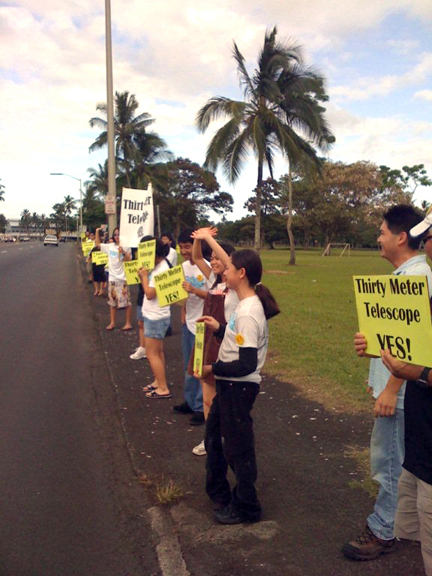Nine months into discussions about what will be important to our community if the Thirty-Meter Telescope (TMT) comes to the Big Island, I feel that we can get at least $100 million for the education of our children over the next 50 years. At a minimum; it could be more.
Last summer, I wrote a post speculating about how the TMT could benefit our island if it were built here on Mauna Kea. I wrote:
I’m on the board of the Hawai’i Island Economic Development Board, and we’ve made it clear that this can only happen if, unlike with previous telescopes, our people clearly benefit from it.
That post last August had a lot of “What ifs,” regarding how our people could benefit from the siting of this telescope here, as opposed to what’s happened with past and current telescopes.
We have made a lot of progress. It’s pretty amazing how far we’ve come, and how many of those “What Ifs” have been addressed.
In their draft Environmental Impact Statement (EIS), the TMT people have committed to a community benefit package as well as a higher education package. I wrote last week, before the draft EIS was published, that the community benefit package will consist of at least $1 million dollars annually for the education of our keiki.
The higher education package will even surpass the community benefit package.
This means that the TMT will be giving at least $2 million per year, over the next 50 years, for the education of our Big Island children. That’s for both kids in K-12 ($1 million/year) and those in higher education (Hawai’i Community College and the University of Hawai’i at Hilo; $1 million/year).
Two million dollars for education every year for the next 50 years. At least $100 million over the next 50 years.
It’s a far, far cry from the $1/year rent that telescopes pay now.
The money for younger kids is to help kids so they are in a position to succeed when they are in high school-that is the whole objective. It takes smart people to do that; educators, not us. We’re just putting in the framework so the smart people can figure out how to do that in these times. The money would be administered through a foundation by seven people, chosen geographically from around the island. Programs will apply for grants.
From my post last August:
• What if the TMT coming here meant disadvantaged Hawaiian (and other race) students can attend Hawai’i Community College and the University of Hawai’i at Hilo for free?
That discussion is going on right now. People are looking at the “unmet needs” of these students.
• What if we develop a pathway for local people to fill jobs during the extensive construction and operating of the telescope?
The TMT’s Environmental Impact Statement addresses work force development. They are looking at developing the skills of today’s ninth graders, so they will be ready to step into jobs that open up when the TMT is built eight years from now.
• What if we collect all the funds attributable to astronomy and have that money administered by a group of wise people who are chosen specifically to allocate it to the education of this island’s keiki?
The Hawaii Island Economic Development Board set up the framework and governance of this fund specifically for the education of our keiki, emphasizing K-12. It will be administered by the Hawaii Community Foundation.
• What if these credible people fund education programs about the Hawaiian culture and Hawaiian language, and about traditional ways of sustainability, the sciences, job skills and other subjects that prepare our children for a new world where we, living on the island of Hawai’i, might have to survive on what exists here on our island?
We recognize that not all students are suited for a career in astronomy. A certain percentage of this fund is set aside for Hawaiian cultural and traditional approaches.
• And what if this organization exists far into the future and benefits many generations to come?
An annual contribution will ensure this. In addition, wise administration of these funds will ensure benefit to future generations.
• What if, not at the summit though on Mauna Kea, the world’s finest and most powerful telescope looks back in time to the beginning, seeking the answer to the question, “Are we alone?”…
If the TMT helps our people to help their keiki succeed, our people will help the TMT succeed.
…while on the ground, the people have learned how to restore the ancient fish ponds, and are supplementing that with modern aquaculture methods that don’t require oil? And the people on the island’s windward side are using their abundant water to again grow kalo, and growing food with hydroponics, and as in pre-Western times they are able to feed everybody without depending on foreign oil?
A rising tide raises all boats.
It would be the best of the future and the best of the past. What if?
We have some answers to our What Ifs now, and they are pretty impressive.










